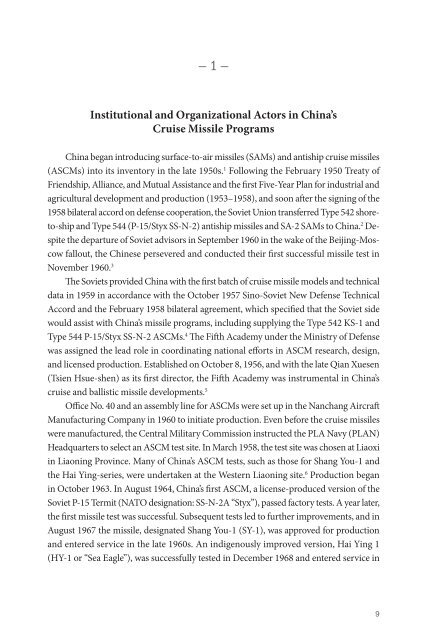Create successful ePaper yourself
Turn your PDF publications into a flip-book with our unique Google optimized e-Paper software.
— 1 —<br />
Institutional and Organizational Actors in China’s<br />
Cruise Missile Programs<br />
China began introducing surface-to-air missiles (SAMs) and antiship cruise missiles<br />
(ASCMs) into its inventory in the late 1950s. 1 Following the February 1950 Treaty of<br />
Friendship, Alliance, and Mutual Assistance and the first Five-Year Plan for industrial and<br />
agricultural development and production (1953–1958), and soon after the signing of the<br />
1958 bilateral accord on defense cooperation, the Soviet Union transferred Type 542 shoreto-ship<br />
and Type 544 (P-15/Styx SS-N-2) antiship missiles and SA-2 SAMs to China. 2 Despite<br />
the departure of Soviet advisors in September 1960 in the wake of the Beijing-Moscow<br />
fallout, the Chinese persevered and conducted their first successful missile test in<br />
November 1960. 3<br />
The Soviets provided China with the first batch of cruise missile models and technical<br />
data in 1959 in accordance with the October 1957 Sino-Soviet New Defense Technical<br />
Accord and the February 1958 bilateral agreement, which specified that the Soviet side<br />
would assist with China’s missile programs, including supplying the Type 542 KS-1 and<br />
Type 544 P-15/Styx SS-N-2 ASCMs. 4 The Fifth Academy under the Ministry of Defense<br />
was assigned the lead role in coordinating national efforts in ASCM research, design,<br />
and licensed production. Established on October 8, 1956, and with the late Qian Xuesen<br />
(Tsien Hsue-shen) as its first director, the Fifth Academy was instrumental in China’s<br />
cruise and ballistic missile developments. 5<br />
Office No. 40 and an assembly line for ASCMs were set up in the Nanchang Aircraft<br />
Manufacturing Company in 1960 to initiate production. Even before the cruise missiles<br />
were manufactured, the Central Military Commission instructed the PLA Navy (PLAN)<br />
Headquarters to select an ASCM test site. In March 1958, the test site was chosen at Liaoxi<br />
in Liaoning Province. Many of China’s ASCM tests, such as those for Shang You-1 and<br />
the Hai Ying-series, were undertaken at the Western Liaoning site. 6 Production began<br />
in October 1963. In August 1964, China’s first ASCM, a license-produced version of the<br />
Soviet P-15 Termit (NATO designation: SS-N-2A “Styx”), passed factory tests. A year later,<br />
the first missile test was successful. Subsequent tests led to further improvements, and in<br />
August 1967 the missile, designated Shang You-1 (SY-1), was approved for production<br />
and entered service in the late 1960s. An indigenously improved version, Hai Ying 1<br />
(HY-1 or “Sea Eagle”), was successfully tested in December 1968 and entered service in<br />
9


